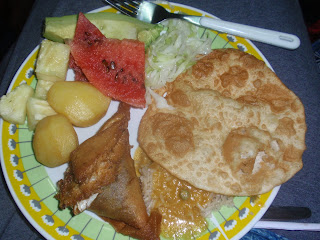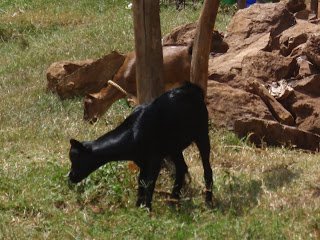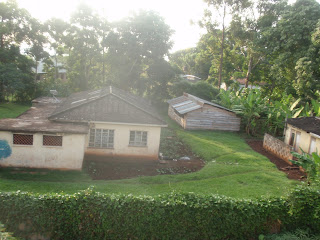 Okay, I’ll admit it. I was afraid of African food when I visited Uganda last year. My travel doctor had me more than a little worried, to the point that I wasn’t sure I should eat anything. I took quite a bit of my own food and ordered foods that sounded American, only trying traditional Ugandan foods when I had to –big mistake!
Okay, I’ll admit it. I was afraid of African food when I visited Uganda last year. My travel doctor had me more than a little worried, to the point that I wasn’t sure I should eat anything. I took quite a bit of my own food and ordered foods that sounded American, only trying traditional Ugandan foods when I had to –big mistake!I changed my MO this year and indulged in traditional Ugandan cuisine. It was fantastic! Somehow, even the foods I hesitantly sampled last year seemed much tastier this year. As you might guess, due to the fact that refrigeration is limited, the food is extremely fresh. The milk comes straight from cow to you;

eggs are gathered and sold daily;

vegetables are fresh-picked and plentiful; and meats are, for the most part, butchered and consumed the same day.
Rice is part of most meals, and is often topped with a stew of chicken, beef, or goat meat.

The children of Smile Africa drink rice porridge for breakfast


and eat a heaping plate of rice for lunch.

In fact, their diet consists solely of rice, besides the fruit they have been served once a week since our visit last year, and what they retrieve from the garbage when they are on the streets.
Beans are a frequent accompaniment, as are potatoes -either Irish potatoes (boiled) or chips (French fries). But fried chicken is common as well, and tilapia, whether baked or fried, is simply delicious.

Another very common dish is matoke (mah-toe-keh), or green bananas. Green bananas are sold in the markets.

And carried home in giant bunches on bicycles.

They are steamed for hours over a charcoal fire, turning them from white to yellow. Matoke is served wrapped in banana leaves.
Brown nut sauce (which is actually red, tastes like warm peanut butter, and makes just about anything taste good) is often poured over matoke, rice, potatoes, or vegetables.
Fresh fruits were offered daily. Sweet bananas,

watermelon, pineapple, and papaya are common during this, Uganda’s winter season. Fresh squeezed passion fruit juice was a delicious treat.
Samosas are yummy triangle-shaped meat or vegetable filled pouches that could be likened to egg rolls. Pastor Ruth serves the best samosas made in Uganda!


The Prime Hotel makes some delicious ones, too. The most “interesting” ones we had were filled with peas and served for breakfast.
Chapati is a popular, tasty, fried flat bread. Mmmmm! I’m getting hungry just thinking about it. Ugandans rarely use silverware when they eat (which is one reason why hand washing is always offered in one form or another before meals).


We ate with our hands sometimes, too, although we always had flatware in the hotel. Chapati makes a good “scoop” for rice, beans, and stew.

Vegetables are plentiful, and they are prepared and served many different ways. One of my favorite vegetable dishes was avocado and cabbage salad. We also had tomatoes, cucumbers, greens (warm and flavorful), sweet potatoes (white, not yellow), sweet corn (Iowa's is still the best!), green beans, peas, and pumpkin.
A variety of sodas are available at the hotels, and I have to comment on one that some of us discovered -Novida pineapple. It is amazing!

I did a little research since returning home and discovered that it is made by the coca cola company, but only distributed in Kenya and Uganda. It is considered one of very few “malt sodas,” which might explain why it looks like beer. It’s non-alcoholic, though –really!
Ugandan fast food is definitely an experience! We stopped at Chicken on a Stick on the way to Tororo from Kampala, and on the way back. Chicken, gizzards, and goat roasted on long sticks are thrust into your vehicle from all sides. Roasted bananas and a variety of sodas and fresh fruits and vegetables are also available.


You may be wondering why I haven’t mentioned posho yet, since I entitled this post, “Pass the Posho, Please.” Well, posho isn’t my favorite Ugandan dish. Being from Iowa, I’m a big fan of sweet corn. Corn is grown everywhere in Uganda, too, but it mostly ends up being served as posho. Posho is white, pasty, mushy, tasteless ground corn. It would be easy to mistake it for mashed potatoes in the photo below.

The students of Entebbe Early Learning Center eat posho every day. We were to eat it too, on the day that we visited. I was a little nervous about this, knowing that I needed to be a gracious guest and a good example to the children. Yet I wondered if I would be able to choke it down. Fortunately, the posho at the school was topped with a tasty mixture of beans and vegetables. It was unbelievable how much easier it was to eat the posho when served that way. I learned that it is often topped with stew, beans, vegetables, or brown nut sauce.
“You do not like them. So you say. Try them! Try them! And you may. Try them and you may, I say.” In case you don’t read Dr. Seuss as often as I do, that is a quote from his book, Green Eggs and Ham, a book I often read to my students and grandchildren. These words came to mind many times as I tried on this trip to take a more courageous approach to eating in Uganda. It worked! I relaxed, tried nearly everything that was offered, and, in the end I decided that Ugandan cuisine is delicious!
Another quote by a famous author came to mind on several occasions as well. “O taste and see that the Lord is good; How blessed is the man who takes refuge in Him.” David penned these words in Psalm 34:8 (NASV) I now realize what I missed out on by refusing to taste more of Uganda last year. In addition to all the foods I’ve mentioned so far, I am so glad that I tasted sugar cane! What a treat!

Wouldn’t it be tragic to miss out on God’s goodness simply due to a fear of tasting?
In Uganda the fear of tasting God’s goodness runs deep. Witch doctors, so much a part of Africa’s history and culture, fight their own demise by fueling that fear. Pastor Ruth was instrumental in building a well and starting a church in her family’s home village outside Tororo. The church quickly outgrew their first building. Part of our team visited and ministered in the new village church that now meets under a tent of sorts.

They showered more of God’s love on these hungering and thirsting people. Nearly everyone in the village -even the witch doctor- attended the church service!
Pastor Phillip,

Pastor Steven,

and Pastor Amos (no picture) could all benefit from your prayers. All three of these men are ministering in small villages, serving up heaping helpings of God’s goodness. All three lack formal training and have few resources, even for their own families, yet they all have a passion for serving Jesus! They have tasted and seen His goodness, power, and might.
And I have tasted, too, both in the literal and the spiritual sense. I feel very fortunate to have tasted so many delicious foods in a country where many are starving. I met many children who would need no coaxing to try green eggs and ham; children who are grateful for the same bland cup of porridge, plate of rice, or posho they receive six days a week. I can't wait to return to Uganda and eat their delicious food again, and with only the slightest hesitation I'll say, "Pass the posho, please!"





































